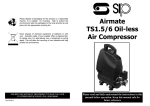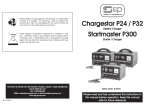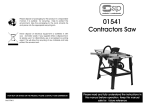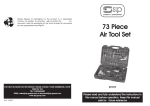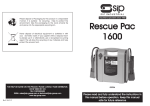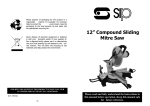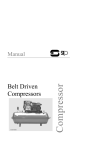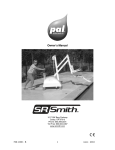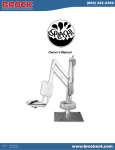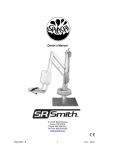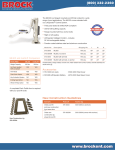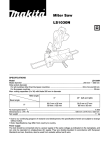Download 14 inch pro bandsaw 060406
Transcript
Please dispose of packaging for the product in a responsible manner. It is suitable for recycling. Help to protect the environment, take the packaging to the local amenity tip and place into the appropriate recycling bin. Never dispose of electrical equipment or batteries in with your domestic waste. If your supplier offers a disposal facility please use it or alternatively use a recognised re-cycling agent. This will allow the recycling of raw materials and help protect the environment. FOR HELP OR ADVISE ON THIS PRODUCT PLEASE CALL OUR CUSTOMER SERVICE HELP LINE : 01509 500359 Ref: 060420 40 Professional 14” Wood-cutting Bandsaw Please read and fully understand the instructions in this manual before operation. Keep this manual safe for future reference 1 DECLARATION OF CONFORMITY DECLARATION OF CONFORMITY WE SIP LTD GELDERS HALL ROAD SHEPSHED LOUGHBOROUGH LEICESTERSHIRE LE12 9NH Declare that the SIP 14” Pro Wood Cutting Band saw SIP Pt No: 01444 Complies with the following EEC Directives their supporting Statutory Instruments and the relevant standard where applicable: 98/37/EEC Machinery Directive 73/23/EEC As Amended by 93/68/EEC Low Voltage Directive 89/336/EEC EMC Directive EN 55014-1:2000 EN 61000-3-2:2000 EN 61000-3-3:1995+A1 EN 55014-2:1997 Signed: Joint Managing Director Date: 25 January 2006 2 39 OPTIONAL EXTRAS CONTENTS SIP Pro wheel kit (SIP part no. 06920): The wheel kit allows the saw to be effortlessly moved from point to point, The same kit also fits most of the other SIP Pro woodworking products. 38 Page No. Description 3. Contents 4. General safety instructions 6. Specific safety instructions 8. Safety symbols 8. Safety symbols used throughout this manual 9. Safety devices 10. Technical specifications 10. Accessories 11. Getting to know your band saw 12. Guarantee 13. Electrical connection 14. Assembly instructions 20. Operating instructions 26. Maintenance 28. Troubleshooting 30. Exploded drawing A 31. Exploded drawing B 32. Exploded drawing C 33. Parts list 37. Notes 38. Optional extras 39. Declaration of conformity 3 GENERAL SAFETY INSTRUCTIONS NOTES Please read the following instructions carefully, failure to do so could lead to serious personal injury. When using electric tools, basic safety precautions should always be followed to reduce the risk of fire, electric shock and personal injury. Read all these instructions before operating the tool and save this user manual for future reference. SIP recommends that this tool should not be modified or used for any application other than that for which it was designed. If you are unsure of its relative applications do not hesitate to contact us using the telephone number on the back of this user manual, and we will be more than happy to advise you. KNOW YOUR POWER TOOL: Read and understand the owner's manual and labels affixed to the saw. Learn its applications and limitations, as well as the potential hazards specific to this tool. KEEP WORK AREA CLEAN AND WELL LIT: Cluttered work benches and dark areas invite accidents. Floors must not be slippery due to oil, water or sawdust etc. DO NOT USE THE SAW IN DANGEROUS ENVIRONMENTS: Do not use power tools in damp or wet locations, or expose them to rain. Provide adequate space surrounding the work area. Do not use in environments with a potentially explosive atmosphere. KEEP CHILDREN AND UNTRAINED PERSONNEL AWAY FROM THE WORK AREA: All visitors should be kept at a safe distance from the work area. STORE TOOLS SAFELY WHEN THEY ARE NOT IN USE: All tools should be stored in a dry, locked cupboard and out of the reach of children. WEAR THE CORRECT CLOTHING: Do not wear loose clothing, neckties, rings, bracelets, or other jewellery, which may get caught in moving parts. Non-slip footwear is recommended. Wear protective hair covering to contain long hair. Roll long sleeves up above the elbow. USE SAFETY GOGGLES AND EAR PROTECTION: Wear CE approved safety goggles at all times, Normal spectacles only have impact resistant lenses, they are NOT safety glasses. A face or dust mask should be worn if the operation is dusty and ear protectors (plugs or muffs) should be worn, particularly during extended periods of operation. PROTECT YOURSELF FROM ELECTRIC SHOCK: When working with power tools, avoid contact with any earthed items (e.g. pipes, radiators, hobs and refrigerators, etc.). It is advisable wherever possible to use an RCD (residual current device) at the mains socket. STAY ALERT: Always watch what you are doing and use common sense. Do not operate the saw when you are tired or under the influence of alcohol or drugs. DISCONNECT THE TOOL FROM THE MAINS SUPPLY: When not in use, before servicing and when changing accessories such as cutters, etc. AVOID UNINTENTIONAL STARTING: Make sure the switch is in the OFF position before connecting the tool to the mains supply. 4 37 PARTS LIST….cont Ref. GENERAL SAFETY INSTRUCTIONS….cont Description Ref. Description 316. Roller, gauge 347. Rod, gear 320. Self tapping screw 348. Gear 321. Cap, fence 349. Washer 8 mm 322. Plate, fence 350. PVC Sticker 323. Counter sunk screw M5 x 8 351. Right cap, fence guide 324. Fence 352. Rod, lock handle 325. Wing nut M6 353. Scale 326. Guide plate, screw 354. Left cap, fence rail 327. Countersunk screw M6 x 10 355. Fence rail 328. Carriage bolt M6 x 70 356. Rack, fine adjust 329. Jointer fence 357. Wing screw 330. Pan head screw M4 x 6 358. Right cap, fence rail 331. Washer 359. Screw guide, plate 332. Len 360. “L” fence 333. Allen bolt M6 x 10 361. Lock plate 334. Left cap, fence guide 362. Cap, lock handle 335. Fence guide 336. Lock handle, fence 337. Hex nut M8 338. Lock eccentric cam 339. Square nut M5 340. Lock washer 5 mm 341. Pan head screw M5 x 8 342. Set screw M6 x 8 343. Handle, fine adjust 344. Spring, gear NEVER LEAVE THE TOOL RUNNING / CONNECTED WHILST UNATTENDED: Turn off the tool and disconnect it from the mains supply between jobs. Do not leave machine until it comes to a complete stop. DO NOT ABUSE THE MAINS LEAD: Never attempt to move the saw by means of the mains lead or pull it to remove the plug from the mains socket. Keep the mains lead away from heat, oil and sharp edges. If the mains lead is damaged, it must be replaced by the manufacturer or its service agent or a similarly qualified person in order to avoid unwanted hazards. CHECK FOR DAMAGED PARTS: Before every use of the tool, a guard or other part that is damaged should be carefully checked to determine that it will operate correctly and perform its intended function. Check for alignment of moving parts, free running of moving parts, breakage of parts, and any other conditions that may affect its operation. A guard or other part that is damaged should be correctly repaired or replaced by an authorized service centre unless otherwise indicated in this instruction manual. Have defective switches replaced by an authorized service agent. Do not use the tool if the switch does not turn it on and off. KEEP ALL GUARDS IN PLACE: And in full working order. MAINTAIN TOOLS WITH CARE: Keep tools sharp and clean for the best and safest performance. Follow instructions for lubricating and changing accessories. All extension cables must be checked at regular intervals and replaced if damaged. USE ONLY RECOMMENDED ACCESSORIES: Consult this user manual for recommended accessories. Follow the instructions that accompany the accessories. The use of improper accessories may cause hazards and will invalidate any warranty you may have. REMOVE ADJUSTING KEYS AND WRENCHES: Form a habit of checking to see that keys and adjusting wrenches are removed from the tool before every use. DO NOT OVERREACH: Keep proper footing and balance at all times. USE THE RIGHT TOOL: Do not use the tool or attachment to do a job for which it was not designed. DO NOT FORCE THE TOOL: It will do the job better and more safely at the rate which it was designed. DO NOT OPERATE POWER TOOLS IN EXPLOSIVE ATMOSPHERES: Do not use the tool in the presence of flammable liquids, gases, dust or other combustible sources. Power tools may create sparks which can ignite the dust or fumes. DO NOT EXPOSE THE TOOL TO RAIN OR USE IT IN WET CONDITIONS: Water entering a power tool will greatly increase the risk of electric shock. HAVE YOUR TOOL REPAIRED BY A QUALIFIED PERSON: The tool is in accordance with the relevant safety requirements. Repairs should only be carried out by qualified persons using original spare parts, otherwise this may result in considerable danger to the user. 345. Eccentric, fine adjust 346. Seat, fine adjust 36 5 SPECIFIC SAFETY INSTRUCTIONS PARTS LIST….cont 1. Some wood and wood type products, especially MDF (Medium Density Fibreboard) can produce dust that can be hazardous to your health. We recommend the use of an approved face mask with replaceable filters when using this machine in addition to using the dust extraction facility. 2. Approved safety glasses or goggles and ear defenders must be worn when using the saw. 3. Ensure that the band saw is securely fastened to its base and wherever possible secure the base to the floor - When selecting a location for the band saw consideration needs to be given to the size of material to be cut and the area around the Band Saw. 4. Do Not attempt to use for wet cutting operations a fatal electric shock could occur. This machine is to be used for dry cutting only. 5. Do Not over tension the drive belt, the drive belt will last longer if the tension is released after each use. 6. Do Not allow sawdust to build up around the motor or inside the machine. A build up of sawdust is a fire hazard. 7. Do Not stop the blade by forcing the work piece against it or by using sideways pressure. 8. Keep Guards in place and in good working order. 9. Always ensure that the blade guide rollers are set correctly. 10. Do Not start the machine with the blade in contact with the work piece. 11. Check the work piece for any protruding nails, screw heads or anything that could damage the blade. 12. Do Not attempt to modify the machine or its accessories in any way. 13. Do Not use excessive force when feeding the work piece to the blade, feeding the work piece gradually will reduce wear on the machine and blade, increasing its efficiency and operating life. 14. For your safety; remove the chippings and work debris etc. from the table top and from inside the extraction port before each operation. 15. Keep hands out of path of saw blade, never reach around saw blade. 16. Before making the first cut using the saw, let it run for a while; Watch for vibration or wobbling that could indicate poor installation or a poorly balanced blade. Adjust or replace as necessary. 16. Allow the blade to run up to full speed before cutting. 17. Stop operation immediately if you notice anything abnormal. 18. Wait for the saw blade to stop completely and remove the plug from the mains supply before servicing or adjusting tool. 19. Be alert at all times, especially during repetitive, monotonous operations. Don't be lulled into a false sense of security. Blades are extremely unforgiving. 20. Use of improper accessories may cause damage to the saw and surrounding area as well as increasing the risk of injury. 21. Turn off the saw and wait for it to complete stop before moving work-piece or changing settings. Ref. 6 Description Ref. Description 113. Flower screw & shaft, lower guide 220. Grounding terminal 114. Lock lever, table tilt 221. View window 115. Guide base, lower guide 222. Door, lower 116. Pointer, table tilt 223. Bushing, micro-switch 117. Guide rod, bearing 224. Hex nut M22 x 1.5 118. Guard left, lower guide 225. Tongue lock 119. Guard right, lower guide 226. Lock washer 120. Lock nut M8 227. Suction connection 228. Strain relief 201. Cross head screw M5 x 10 229. Cross pan head screw M4 x 45 202. Spring plate 230. Cross pan head screw M4 x 30 203. Spring-seat 231. Hex bolt M6 x 10 204. Washer 5 mm 205. Rivet 301. Mitre gauge knob 206. Slotted insert 302. Washer 8 mm 207. Lock housing 303. Scale, gauge 208. Nylon washer 304. Fence, gauge 209. Door, upper 305. Carriage bolt M6 x 40 210. Copper ring 306. Pan head screw M4 x 8 211. Rubber bushing 307. Hex nut M4 212. Micro-switch 308. Mitre gauge rod 213. Washer 4 mm 309. Mitre gauge base 214. Serrated washer 4 mm 310. Washer 6 mm 215. Hex nut M4 311. Thumbnut M6 216. Power switch 312. Pan head screw M5 x 10 217. Cross pan head screw M4 x 12 313. Indicator, gauge 218. Rivet 2 x 5 314. Block, indicator 219. Cross pan head screw M4 x 6 315. Stop pin 35 PARTS LIST….cont SPECIFIC SAFETY INSTRUCTIONS….cont 22. Do not modify the saw to do tasks other than those intended. 23. Keep the site free of tripping hazards. Ensure adequate lighting conditions. 24. The saw must only be operated with all correctly mounted guards etc. 25. Never use cracked or distorted saw blades - Only user sharp saw blades. 26. Use a push stick when rip sawing narrow work-piece. Ref. Description Ref. Description 57. Saw blade 85. Hex nut MI6 58. Lower wheel 86. Cross pan head screw M5 x 16 59. Pulley drive 87. Mount, pointer 60. Belt "A" 88. Hex nut M5 Blade Safety: 61. Dual thread screw, bracket 89. Hand wheel 62. Shaft, lower wheel 90. Thread, tension • • 63. Bracket, lower wheel 91. Spring washer 8 mm 64. Ring circle 12 mm 92. Lock lever, wheel tilt 65. Washer 12 mm 93. Lock, flower screw 66. Bearing 80101 94. Parallel pin 67. Ring circle 28 mm 95. flat washer 6 mm 68. Tension pulley 96. Allen bolt M6 x 12 69. Shaft, tension pulley 97. Screw, indicator 70. Collar, tension rod 98. Indicator 71. Screw set M6 x 8 99. Lock eccentric 72. Thread, tension rod 100. Lever, lock eccentric 73. Allen bolt M5 x 30 101. Table insert 74. Hand wheel, tension 102. Table 75. Spacer 103. Hex nut M8 76. Motor pulley 104. Hex screw M8 x 70 77. Screw set M5 x 10 105. Tilt rack 78. Key flat 106. Cross pan head screw M5 x 6 79. Motor 107. Carriage bolt M8 x 80 80. Saw frame 108. Rack, table trunnion 81. Spring washer 12 mm 109. Table trunnion, upper 82. Cap nut M12 110. Allen bolt M10 x 30 83. Spring washer 8 mm 111. Table trunnion, lower 84. Washer 16 mm 112. Flower screw, lower guide 34 • • • • • • • Use only blades that are recommended by the manufacturer. Do Not use blades that are deformed or have missing teeth, this is highly dangerous and could result in a serious accident to the operator and bystanders as well as damaging the machine. Only use blades that are recommended by the supplier and that are in good condition. Ensure that the directional arrow, if marked on the blade corresponds with the rotational direction of the motor, the teeth of the blade should always point downward when viewed from the front of the saw. Always release the blade tension, when the machine is not in use. Always wear gloves and eye protection when fitting or removing blades. Always uncoil blades in spacious areas, away from other people, and take great care. Always keep looped blades secure with tie wires. Always keep fingers away from moving blades. Use of extension leads: • • • • • • DO NOT use 2 core extension leads or reels, always use a 3 core extension lead or reel with an earth. Always unwind any extension leads fully. For extension leads up to 15 metres use a wire cross section of at least 1.5 mm². For extension cords over 15 metres but less than 40 metres use a wire cross section of at least 2.5 mm². Always replace a damaged extension lead before using the band saw. Protect your extension cord from sharp objects, excessive heat and damp or wet locations. CAUTION: The warnings and cautions mentioned in this user manual can not cover all possible conditions and situations that may occur. It must be understood by the operator that common sense and caution are factors which cannot be built into this product, but must be applied. 7 SAFETY SYMBOLS PARTS LIST When using the saw always ensure the operator as well as those in the area wear ear protection. When using the saw always ensure the operator as well as those in the area wear eye protection. Some wood and wood composites have the potential to be highly toxic; always wear a face mask when operating saw. SAFETY SYMBOLS USED THROUGHOUT THIS MANUAL Danger / Caution: Indicates risk of personal injury and/or the possibility of damage. Warning: Risk of electrical injury or damage! Note: Supplementary information. Drawing-in / trapping hazard! Risk of personal injury to body parts or clothing by being drawn into the rotating saw blades. 8 Ref. Description Ref. Description 1. Allen bolt M6 x 20 29. Set collar, worm 2. Eccentric shaft 30. Worm 3. Base, eccentric 31. Insert, upper guide 4. Tyre 32. Gear, upper guide 5. Ring circle 17 mm 33. Thread, gear 6. Bearing 80203 34. Allen bolt M5 x 10 7. Ring circle 40 mm 35. Square tube, upper guide 8. Upper wheel 36. Rack, upper guide 9. Shaft, upper wheel 37. Sunk head screw M5 x 10 10. Tension bracket 38. Cover plate, upper guide 11. Upper wheel carrier bracket 39. Hex screw M8 x16 12. Spring 40. Mount, upper guide 13. Connector 41. Shaft bearing, upper guide 14. Cross pan head screw M4 x 40 42. Washer 6 mm 15. Hex nut M4 43. Carriage bolt M8 x 105 16. Washer 4 mm 44. Brush 17. Upper wheel tension bracket 45. Allen bolt M5 x 10 18. Tension shaft, upper wheel 46. Washer 5 mm 19. Hex nut M6 47. Sliding guard 20. Spacer bushing 48. Safe guard, upper guide 21. Hand wheel 49. Bracket, lower wheel 22. Cross pan head screw M6 x 16 50. Allen bolt M8 x 28 23. Allen bolt M6 x 12 51. Washer 8 mm 24. Lever, hand wheel 52. Bearing 80201 25. Screw set M6 x 10 53. Bush, bearing 26. Mount, upper guide 54. Nut, bearing 27. Thread tube 55. Allen bolt M6 x 16 28. Screw set M4 x 5 56. Guide base, upper guide 33 EXPLODED DRAWING (C) SAFETY DEVICES Blade guide: The blade guide guides the blade safely and accurately, it also covers it to reduce the risk of operator injury. The blade guide should be set so that it sits just above the work-piece during the cutting operation. Dust extraction port: Some wood and wood composites have the potential to be highly toxic, it is advisable to connect an adequate extraction system to the saw whenever it is in use. This will reduce potentially harmful airborne particles from harming the operator as well as those in the working area. On / Off NVR (no volt release) switch: The NVR switch is designed so that if the power to the saw is cut, the switch will automatically switch to the “off” position and will stay in that state even when power is returned to the saw. It will only change if the operator over-rides the switch by pressing the green (1) button. This is to eliminate any chance of the saw starting un-intentionally. Interlock switches: Both the top and bottom doors are fitted with safety interlock switches. These will automatically turn the saw off whenever any of the doors are opened. This is to reduce the risk of operator injury by the unintentional opening of the doors, or if the operator forgets to remove the plug from the mains supply during cleaning or maintenance. 32 9 TECHNICAL SPECIFICATIONS EXPLODED DRAWING (B) Part number 01444 Input voltage 230v ~ 50hz Power 1500 watts (2 hp) Minimum speed (no load) 8m/sec. Maximum speed (no load) 14m/sec. Blade length 2750 mm Blade width 6 mm-25 mm Maximum work-piece height 235 mm Maximum cutting width 345 mm Table size 435 mm x 535 mm Table height (with stand) 49” (1250 mm) Table tilt angle (maximum) 45° ACCESSORIES Bearing guide hand-wheel. Belt tension hand-wheel. Main table. Rip-fence guide rail. Rip fence. Auxiliary fence (Rip-fence). Mitre gauge. Auxiliary fence (mitre gauge). NVR switch cover. Cabinet stand - 1 x bottom panel, 1 x front panel, 1 x rear panel, 2 x side panels and 1 x fixing kit. IF ANY OF THE ABOVE ITEMS ARE MISSING or DAMAGED; CONTACT YOUR DISTRIBUTOR IMMEDIATELY. 10 31 EXPLODED DRAWING (A) GETTING THE KNOW YOUR BAND SAW A M L O J B N K I H C P T S F G E R D See page 12 for descriptions 30 11 Q GETTING THE KNOW YOUR BAND SAW….cont Ref. Description Ref. Description A. Blade Tension Fine Adjustment Hand-wheel K. Rip Fence B. Blade Tension Indicator Window L. Blade Guide Locking Knob C. Main On / Off Switch (NVR) M. Blade Tension Quick Release Lever D. Cabinet stand N. Blade Tracking Knob E. Belt Tension Hand-wheel O. Blade Tracking Lock Lever F. Rip-fence Micro Adjust Knob P. Table Tilt Knob G. Rip-fence Locking Handle Q. Motor H. Mitre Gauge R. 4" Dust Extraction Port I. Blade Guide (rack and pinion) S. Mains Lead J. Blade Guide Rise / Fall Hand-wheel T. Table Tilt Locking lever TROUBLESHOOTING….cont Problem Sawdust builds up inside the machine: Possible Cause • Table saw vibrates exces- • sively: • • • Fuses or circuit breakers • blow or open frequently: • • • This is normal. • Regularly clean out sawdust from all areas of the saw. Use of an adequate dust extractor will minimize this issue. Floor surface is uneven. V-belt is damaged. Saw blade is damaged. Loose bolt, Screws, Nuts. • Sit the saw on a level surface. Replace the V-belt. Replace the Saw Blade. Tighten all Hardware. Motor is overloaded. Fuses or circuit breakers are wrong size or defective. Dull saw blade. Power Switch or motor is defective. • GUARANTEE Guarantee: This saw is covered by a 36 month parts and labour warranty covering failure due to manufacturers defects. This does not cover failure due to misuse or operating the machine outside the scope of this manual. In the unlikely event of warranty claims, contact your distributor or contact our help line on the back page of this manual. Proof of purchase will be required before any warranty can be honoured. 12 Remedy 29 • • • • • • Feed work-piece more slowly. Replace fuses or circuit breakers. Replace the saw blade. Have the Power Switch or motor checked, repaired or replaced. TROUBLESHOOTING Problem ELECTRICAL CONNECTION Possible Cause The machine does not work • when switched on: • • • Damaged mains lead. Problem with the electrical supply. Defective switch. Defective motor. Remedy • • • • The blade does not move with the motor running: • • • • The blade does not cut in a straight line: • • • • The quick release lever or blade tension handwheel has not been tightened. The blade has fallen from one of the wheels. The saw blade has broken. The drive belt has snapped. • • • • Rip-fence for not used • or incorrectly fitted. Feed rate too fast. • The blade teeth are dull or damaged. Blade guides not cor• rectly adjusted. • The blade does not cut, or cuts very slowly: • • • • The teeth on the blade are dull. Incorrect blade being used for the type of cut / material. Wrong speed being used for type of cut / material. The blade was mounted in the wrong direction. 28 • • • • Check the cable for damage. Check for power at the mains. Have the switch checked, repaired / replaced. Have the motor checked, repaired / replaced. Switch off the motor, tighten the quick release lever and/or blade tension hand-wheel. Open the door and check the blade, replace as necessary. Check the blade , replace as necessary. Check the belt and replace as necessary. Use a fence, check for correct alignment. Use lighter pressure on the work-piece & allow the saw to do the cutting. Replace the damaged blade with a new one. Adjust the blade guides. Replace the blade. Fit the correct blade. Change the speed of the blade. Fit the blade correctly. Connecting to the power supply: This SIP “Pro” band saw is fitted with a standard 230v ~ plug. Before using the tool inspect the cable and plug to ensure that neither are damaged. If any damage is visible have the tool inspected / repaired by a suitably qualified person. If it is necessary to replace the plug a heavy duty impact resistant plug would be preferable. The wires for the plug are coloured in the following way: Yellow / green Blue Brown Earth Neutral Live As the colours of the wires may not correspond with the markings in your plug, proceed as follows: The wire which is coloured blue, must be connected to the terminal marked with N or coloured black. The wire which is coloured brown, must be connected to the terminal, which is marked L or coloured red. The wire which is coloured yellow / green should be connected to the terminal which is coloured the same or marked Always secure the wires in the plug terminal carefully and tightly. Secure the cable in the cord grip carefully. Warning: Never connect live or neutral wires to the earth terminal of the plug. Only fit an approved plug with the correct rated fuse (16 amp). If in doubt consult a qualified electrician. Note: Always make sure the mains supply is of the correct voltage and the correct fuse protection is used. In the event of replacing the fuse always use a 13A fuse. Note: If an extension lead is required in order to reach the mains supply; ensure that this too is rated for the correct voltage and fuse rating. Note: The cross section of the extension lead should be checked so that it is of sufficient size so as to reduce the chances of voltage drops. 13 ASSEMBLY INSTRUCTIONS MAINTENANCE….cont Assembling the cabinet stand: • • • Place the new drive belt over the pulley on the main drive-wheel. Re-fit the drive-wheel to the saw and fully tighten the lock nut to secure. Follow the instructions on pages 17 and 19 to re-fit the blade and to re-tension the drive belt. Cleaning: 14 ⇒ Always remove excess chippings and waste debris from the band-saw, pay particular attention around the motors air inlets, failure to do so could result in overheating and even fire. ⇒ Periodically clean and lubricate the internal moving parts of the band-saw such as the rack and pinion blade guide assembly, belt tension screw, table tilting assembly and the belt tension assembly to ensure easy accurate adjustments. 27 MAINTENANCE ASSEMBLY INSTRUCTIONS….cont Ref. No. Description Ref. No. Description 371. Bottom Panel 379. Rear panel 372. Bolt M8 x 16 380. Front beam Checking and setting the table angle: 373. Washer 8 mm 381. Left side panel The angle between the blade and the main table of the saw is accurately set at the factory. However time and use of the band-saw may mean that this angle needs to be checked and re-set. 374. Allen bolt M6 x 20 382. Door 375. Door lock 383. Allen bolt M6 x 20 376. Washer 6 mm 384. Nut M8 • 377. Nut M6 385. Bolt M8 x 50 378. Right side panel 386. Lock nut M6 Caution! Before carrying out any maintenance, ensure that the band-saw is turned off and that the plug is removed from the mains supply. Place a suitable set square (or similar) against the table and the blade. Table stop screw • Fit the right hand and left hand side panels to the bottom panel and secure with: Scale pointer ⇒ ⇒ 4 x M8 x 16 bolts. 4 x 8 mm washers. Tilt locking handle • • • • • Note: The left and right hand panels are similar; to tell the difference, the left hand panel has the hinges for the door and the right hand panel has a hole on the outside where the door lock will fit. Loosen the table tilt locking handle and adjust the table until it is accurately set to 90° to the blade. If necessary adjust the table stop screw underneath the table. Once the angle is accurately set, lock off the tilt locking handle. Check that the scale pointer reads 0°. If it does not, loosen the screw and set the pointer at 0 and re-tighten the screw. Replacing the drive belt: • • • Remove the blade (see page 17). Release tension from the drive belt (see page 19). Loosen and remove the drive wheel securing nut and washer (located at the rear of the saw). Note: It may be necessary to tap the threaded section of the shaft with a soft faced mallet to remove the drive wheel. 26 Drive wheel securing nut • Fit the rear panel and secure it to the left and right panels with: ⇒ ⇒ 6 x M8 x 16 bolts. 6 x 8 mm washers. • Fit the upper and lower front beams and secure to the left and right side panels with: ⇒ ⇒ 4 x M8 x 16 bolts. 4 x 8 mm washers. Fitting the door lock: • • • Insert the M6 x 20 Allen bolt through the hole in the door lock. Fit both through the hole on the outside of the right hand panel. Secure with the M6 lock nut. Note: The lock nut should be tightened enough to secure the door lock, but not so tight that the door lock does not turn. 15 ASSEMBLY INSTRUCTIONS….cont OPERATING INSTRUCTIONS….cont Fitting the locking bolt to the door: • • • • • Screw 1 x M6 nut approximately half way up the M6 x 20 Allen bolt. Fit it into the hole on the right hand edge of the door, ensuring that the head of the bolt faces outward. Turn a second M6 nut onto the bolt to hold it in place. Fully secure by tightening the nuts against each other. With the power supply still disconnected rotate the blade wheel by hand ensuring that the blade does not catch on the guides, re-set as necessary. Note: When using narrow blades, the rear blade support bearings need to be in contact with the blade. Lower guide: • • • Loosen (don’t remove) the bearing support screw (B). Slide the bearing left / right until it is in the correct position. Re-tighten the bearing support screws. Fitting the door: • • Line up the female section of the hinges (on the door) with the male section (on the left hand panel), ensuring that the bushes are fitted between. Allow the door to fully slide down on to the hinges, gravity will keep it in place. Note: The red bearing cover has been removed for photographic purposes, it does not need to be removed to adjust the bearing. Bush Grub screw Rear bearing adjustment knob Fitting the saw onto the cabinet stand: • • • Sit the saw on top of the cabinet stand, ensuring that the 4 holes on the corners of the saw and stand line up. Fit 4 x M8 x 50 bolts through the holes and secure with 4 x 8 mm nuts and washers. Fully tighten the nuts / bolts. Caution: Due to the weight of the main saw and other factors, this operation would ideally be carried out by at least 2 persons to reduce the risk of personal injury and / or damage to the machine. 16 • • • • Loosen the locking grub screw. Turn the rear bearing adjustment knob until the rear bearing is in position. Tighten the grub screw to secure the bearing in-place. rotate the blade wheel by hand ensuring that the blade does not catch on the guides, re-set as necessary. 25 OPERATING INSTRUCTIONS….cont ASSEMBLY INSTRUCTIONS….cont Upper guide: This machine is supplied partly assembled, Prior to use, the following items need to be fitted to the band saw: The lateral support bearings should be set so that they are approximately 0.5 mm away from the blade. • • • Loosen (no need to remove) the bearing support screws (A). Slide the bearing assembly left / right until it is in the correct position. Re-tighten the bearing support screws. • • • • The The The The bearing guide hand-wheel blade tension hand-wheel main table rip-fence guide rail Fitting the blade tension and bearing guide hand wheel’s (A and B): A • • A The rear thrust bearings should be set so that they are approximately 3 mm behind the blade. They will only come into contact with the blade as the work-piece is being cut. Due to the many different sizes of band-saw blades available, the rear support bearing needs to have extra movement compared to the lateral support bearings. This is achieved by having 3 different points of movement as opposed to 1 on the lateral support bearings. C A • • • B Allen bolt A - This allows the bearing assembly support pole to be moved and should be utilised when large movement is required. Allen bolt B - This allows the bearing support assembly to be moved on the pole. Allen bolt C - This allows the bearing to move along the channel on the bearing support assembly and should be utilised when only a small amount of movement is required. Loosen the required allen bolt/s. Move the bearing, bearing assembly and/or the pole until the bearing is set in the correct position. Re-tighten all of the allen bolts to secure the bearing in place. 24 • Fit the blade tension hand wheel (A) onto the thread rod, gravity will hold it in place. Fit the bearing guide hand wheel (B) onto the shaft of the worm gear. Secure with the supplied grub screw. B Fitting the table: Caution: Due to the weight of the main saw bed and other factors, this operation would ideally be carried out by at least 2 persons to reduce the risk of personal injury and / or damage to the machine. • • Fit the table onto the table trunnion (C) ensuring that the 4 holes on the trunniun line up with the threaded holes on the bottom of the main table. Fit 4 x M8 x 16 mm securing bolts (D) and hand tighten to secure. Note: The bolts only need to be hand tightened at this point as some adjustment may be necessary to set the table correctly. 17 ASSEMBLY INSTRUCTIONS….cont OPERATING INSTRUCTIONS….cont Caution: Always ensure that the saw is turned off and that the mains lead is removed from the power supply before carrying out any adjustments or maintenance. D Tilting the table to perform bevel cuts: • • • loosen the table tilt locking lever (T). Turn the table tilt knob (P) to tilt the table to the desired angle. Re-tighten the tilt locking lever (T). C Setting the table in the correct position: This instruction assumes that the blade is already fitted, if not, go to the section headed “ Replacing the band saw blade”. • • The blade should sit in the centre of the gap on the table insert, if it does not tap the edge of the table (either left or right depending on which way the table needs to go) with a mallet (a scrap piece of wood and a hammer will suffice if a mallet is not available) until the blade is in the correct position. Proceed to fully tighten the securing bolts (D). Fitting the rip fence guide: • Table tilt knob (P) Table tilt locking lever (T) To fit the Rip Fence, firstly fit the 4 x winged screws and washers (E) supplied into the 4 threaded holes on the bottom of the main table. Note: Compound mitre cuts can be made by using the mitre gauge in conjunction with the table tilting facility. E Note: The winged screws (E) only need to be fitted with a few turns so there is an adequate gap to fit the rip-fence guide (F). 18 Setting up the blade guides: Note: The blade guide minimises blade movement during the cutting operation and ensures a safe accurate cut. 23 OPERATING INSTRUCTIONS….cont ASSEMBLY INSTRUCTIONS….cont Changing the blade speed: • Line the cut-outs on the fence guide with the thumbscrews earlier fitted to the bottom of the main table. • • Push the fence rail forwards against the front edge of the main table. Fully tighten the thumbscrews to secure. • • Release the belt tension fully by turning the belt tension hand-wheel anticlockwise. Open the bottom drive-wheel door. Changing from low speed to high speed: ⇒ The band-saw is set in low speed when the drive belt is in the small Ø channel on the motor pulley and on the large Ø pulley on the Main drive-wheel. • Slowly rotate the main drive-wheel by hand and at the same time ease the drive belt from the large Ø pulley (front) and onto the smaller Ø pulley (rear) on the main drive-wheel. Continue to slowly rotate the main drive-wheel whilst easing the drive belt from small Ø (front) pulley channel onto the larger Ø (rear) pulley channel on the motor pulley. Fully re-tension the drive belt by turning the belt tension hand-wheel clockwise. • • Changing from high speed to low speed: The band-saw is set in high speed mode when the drive belt is in the large Ø channel on the motor pulley and on the small Ø pulley on the main drive wheel. • Slowly rotate the main drive-wheel by hand and at the same time ease the drive belt from the large Ø channel (rear) and onto the small Ø channel (front) on the motor pulley. Continue to slowly rotate the main drive-wheel whilst easing the drive belt from the small Ø (rear) pulley and onto the large Ø (front) pulley on the main drive wheel. Fully re-tension the drive belt by turning the belt tension hand-wheel clockwise. • • • ⇒ • Fitting the Rip-fence: Fit the profile of the rip-fence carrier into the opposite profile on the rip-fence rail. Secure it in the desired position by simply pressing down on the rip-fence locking handle. Main drive wheel Tension assembly Drive belt Motor pulley Belt tension handwheel 22 19 OPERATING INSTRUCTIONS OPERATING INSTRUCTIONS….cont Changing / fitting the blade: Tracking the saw-blade: • • • Remove the rip-fence. Loosen the thumbscrews that secure the rip-fence rail and remove it. Release the blade tracking lock lever by turning it clockwise. Blade tension fine adjustment hand-wheel Blade tracking lock lever Blade tension release lever quick Blade tracking knob • • • • • • • Release the tension on the blade by turning the blade tension quick release lever. Turn the blade tension fine adjustment hand-wheel to fully release the tension (if needed). Remove the blade (if fitted). Fit the new blade around both top and bottom drive-wheels, taking care that the correct size of blade is being fitted and that the direction of the blade is also correct. Note: The teeth of the blade should be pointing downwards if the blade has been fitted in the correct direction. • • With the top door open, turn the drive-wheel by hand. Continue to turn the drive-wheel and at the same time turn the blade tracking knob. Turn both the drive-wheel and the blade tracking knob until the blade is sitting on the centre of the drive-wheel. Return the pressure to the blade by turning the blade tension quick release lever back to its original position. Continue to tension the blade fully by turning the fine adjustment hand-wheel until the red arrow points to the correct blade thickness through the blade tension indicator window. 20 Note: Use the blade tracking window to see where the blade is sitting on the drive-wheel. • • Once the blade has been correctly set, Turn the lock lever clockwise to lock into position. Follow the instructions on page 15 and 16 to re-fit the rip-fence. 21




















